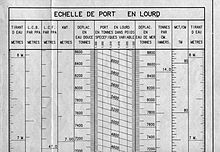

Deadweight tonnage (also known as deadweight; abbreviated to DWT, D.W.T., d.w.t., or dwt) or tons deadweight (DWT) is a measure of how much weight a ship can carry. [1] [2] [3] It is the sum of the weights of cargo, fuel, fresh water, ballast water, provisions, passengers, and crew. [1]
Contents
DWT is often used to specify a ship's maximum permissible deadweight (i.e. when it is fully loaded so that its Plimsoll line is at water level), although it may also denote the actual DWT of a ship not loaded to capacity.